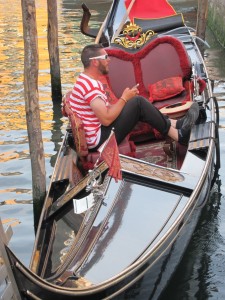We didn’t join the tourist queue for a ride in a gondola, but sitting in the shade with a campari spritz I could watch these boatmen all day.
Gondolas look so ungainly, but in the logjams around tourist pickup points they are handled with remarkable skill and insouciance. The waters are choppy and their loads are heavy but there are no collisions. The vessels turn in their own length. They have absolute right of way – harbour ferries (vaporetti) and taxis back and fill patiently while the gondolas come and go.
By law all gondolas must be painted black. Your gondolier’s licence is inherited – one chap told me his was a 4th generation ticket. As a gondolier you have to follow certain unwritten rules – you must not look anxious, you must never shout (except if exuberant or when singing), and your every fluid move must demonstrate style and balletic elan.
The scull pivots at a single thole pin on the starboard side aft. The pin looks like an large, oddly-shaped elkhorn and provides a number of different pivot points for power (low and high gear) and turning (stern thrusting).
Sculling is an asymmetrical activity. Indeed, the gondolas themselves are asymmetrical. You’d think that degenerative back disorders would be the major occupational issue but I am told that after 15 years as a gondolier your skeletal problems are likely to involve not only your back but medial epicondyles, your right hip joint and both knees.



